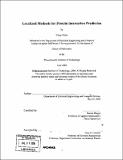| dc.contributor.advisor | Bonnie Berger. | en_US |
| dc.contributor.author | Pulim, Vinay, 1976- | en_US |
| dc.contributor.other | Massachusetts Institute of Technology. Dept. of Electrical Engineering and Computer Science. | en_US |
| dc.date.accessioned | 2009-03-16T19:33:16Z | |
| dc.date.available | 2009-03-16T19:33:16Z | |
| dc.date.copyright | 2008 | en_US |
| dc.date.issued | 2008 | en_US |
| dc.identifier.uri | http://hdl.handle.net/1721.1/44715 | |
| dc.description | Thesis (Ph. D.)--Massachusetts Institute of Technology, Dept. of Electrical Engineering and Computer Science, 2008. | en_US |
| dc.description | Includes bibliographical references (p. 70-74). | en_US |
| dc.description.abstract | Identification of protein-protein interactions is important for drug design and the treatment of diseases. We propose a novel threading algorithm, LTHREADER, which generates accurate local sequence-structure alignments and integrates various statistical scores and experimental binding data to predict interactions. LTHREADER uses a profile of secondary structure and solvent accessibility predictions with residue contact maps to guide and constrain alignments. Using a decision tree classifier and low-throughput experimental data for training, it combines information inferred from statistical interaction potentials, energy functions, correlated mutations and conserved residue pairs to predict likely interactions. The significance of predicted interactions is evaluated using the scores for randomized binding surfaces within each family. We first apply our method to cytokines, which play a central role in the development of many diseases including cancer and inflammatory and autoimmune disorders. We tested our approach on two representative families from different structural classes (all-alpha and all-beta proteins) of cytokines. In comparison with the state-of-the-art threader RAPTOR, LTHREADER generates on average 20% more accurate alignments of interacting residues and shows dramatic improvement in prediction accuracy over existing methods. To further improve alignment accuracy for all PPI families, we also introduce the program CMAPi, a two dimensional dynamic programming algorithm that, given a pair of protein complexes, optimally aligns the contact maps of their interfaces. We demonstrate the efficacy of our algorithm on complexes from PPI families listed in the SCOPPI database and from highly divergent cytokine families. In comparison to existing techniques, CMAPi generates more accurate alignments of interacting residues within families of interacting proteins, especially for sequences with low similarity. | en_US |
| dc.description.statementofresponsibility | by Vinay Pulim. | en_US |
| dc.format.extent | 81 p. | en_US |
| dc.language.iso | eng | en_US |
| dc.publisher | Massachusetts Institute of Technology | en_US |
| dc.rights | M.I.T. theses are protected by
copyright. They may be viewed from this source for any purpose, but
reproduction or distribution in any format is prohibited without written
permission. See provided URL for inquiries about permission. | en_US |
| dc.rights.uri | http://dspace.mit.edu/handle/1721.1/7582 | en_US |
| dc.subject | Electrical Engineering and Computer Science. | en_US |
| dc.title | Localized methods for protein interaction prediction | en_US |
| dc.title.alternative | Protein-protein interaction prediction using local threading | en_US |
| dc.type | Thesis | en_US |
| dc.description.degree | Ph.D. | en_US |
| dc.contributor.department | Massachusetts Institute of Technology. Department of Electrical Engineering and Computer Science | |
| dc.identifier.oclc | 297540063 | en_US |
